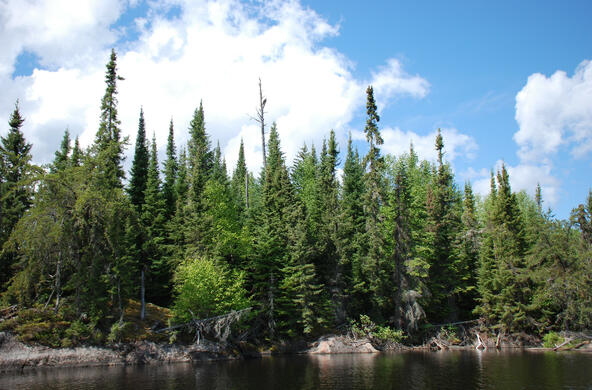The worms invading her surrounding forest, yard and garden have been tentatively identified by earthworm specialists as belonging to the Asian genus Amynthas, Anne MacPherson said Tuesday.
She believes they present a life-or-death threat to the forest trees on her land. The specialists are still investigating the worms that have been devastating MacPherson's soil, and so were withholding comment for the time being.
MacPherson said the worms have destroyed her forest's leaf litter, important for supplying nutrients to the trees, and have invaded her lawn as well.
"There's an island in the middle of the creek that's usually covered with ferns," she said. "There's not a fern there; they're moving fast."
MacPherson said the worms are of concern because they are an invasive species whose population has exploded; they pose a problem for the short-term future of the forest canopy; and "if the forests start to die because of this creature and the emerald ash borer, we're reducing the oxygen in the atmosphere. It has long-range consequences."
As well as eating what trees need to grow, the worms release "an enormous amount of nitrogen into the soil," she said. Her sucker lilacs are twisted and infected with fungus, which she blames on the depletion of nutrients and increased nitrogen in the soil.
Dr. Peter Groffman is a microbial ecologist at the Cary Institute of Ecosystem Studies in Millbrook. One of his current projects is the effect of exotic earthworms on northern temperate forests.
"Most forests have a duff layer (decomposed material) that protects the soil from erosion," he said in an interview Tuesday. "Plants and animals have that as a habitat. That will disappear" — due to the enormous appetites of the earthworms.
Groffman said people began to get concerned 20 or 30 years ago, and he and fellow scientists have been studying the multiple effects on forests since the late 1990s.
"It doesn't get much attention," he said. "People don't pay attention to the soil. But it (the invasion) seems to be accelerating; there seem to be new species coming all the time."
Groffman said there are lots of open questions.
One is a real need for data on how widespread this problem is.
"We have good maps of soil types," he said, "but not of the biological conditions of the soil."
Another is information on how fast the worms are spreading.
"There's a really impressive amount of worms," he said.
Amynthas worms "look different and behave differently than the worms I grew up with," Groffman said; he grew up with the European varieties from the genus Lumbricus, also known as night crawlers, which have been in this country for a couple hundred years.
MacPherson said they have a pointed head and are sometimes called "crazy worms," because they "squiggle around when touched."
Groffman said they haven't seen any forests die in the 14 years the study has been going on.
"We have some evidence of their negative effect on forest trees," he said. "It makes them more sensitive to drought without the duff to act as a mulch layer.
"People ask how to get rid of them," Groffman said. "I think there's no easy way."
Golf course owners use a variety of pesticides, he said, "but it's unlikely to spray pesticides through large areas of forests."
"Once (invasive species) get started, it's hard to get rid of them," he said, citing zebra mussels as an example, "but we could make people more aware."
Worms are spread by fisherman, they're carried in bought compost, they're spread via plants sold in nurseries, Groffman said.
It's important, he suggested, for people to begin to avoid behaviors that could bring in invasive species.
"Where they were, there's nothing growing, not even weeds," MacPherson said. "It looks like a vacuum cleaner hit it. Long-range destruction is something to be worried about."





